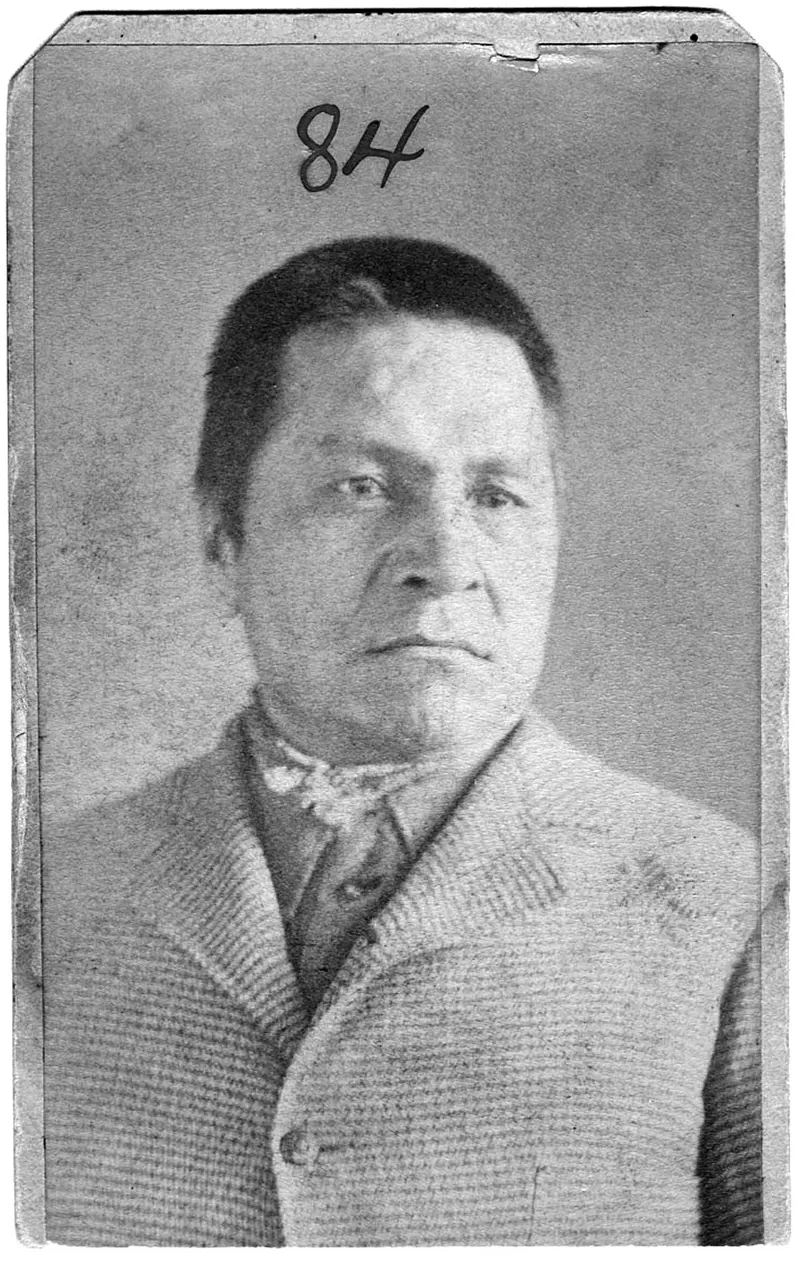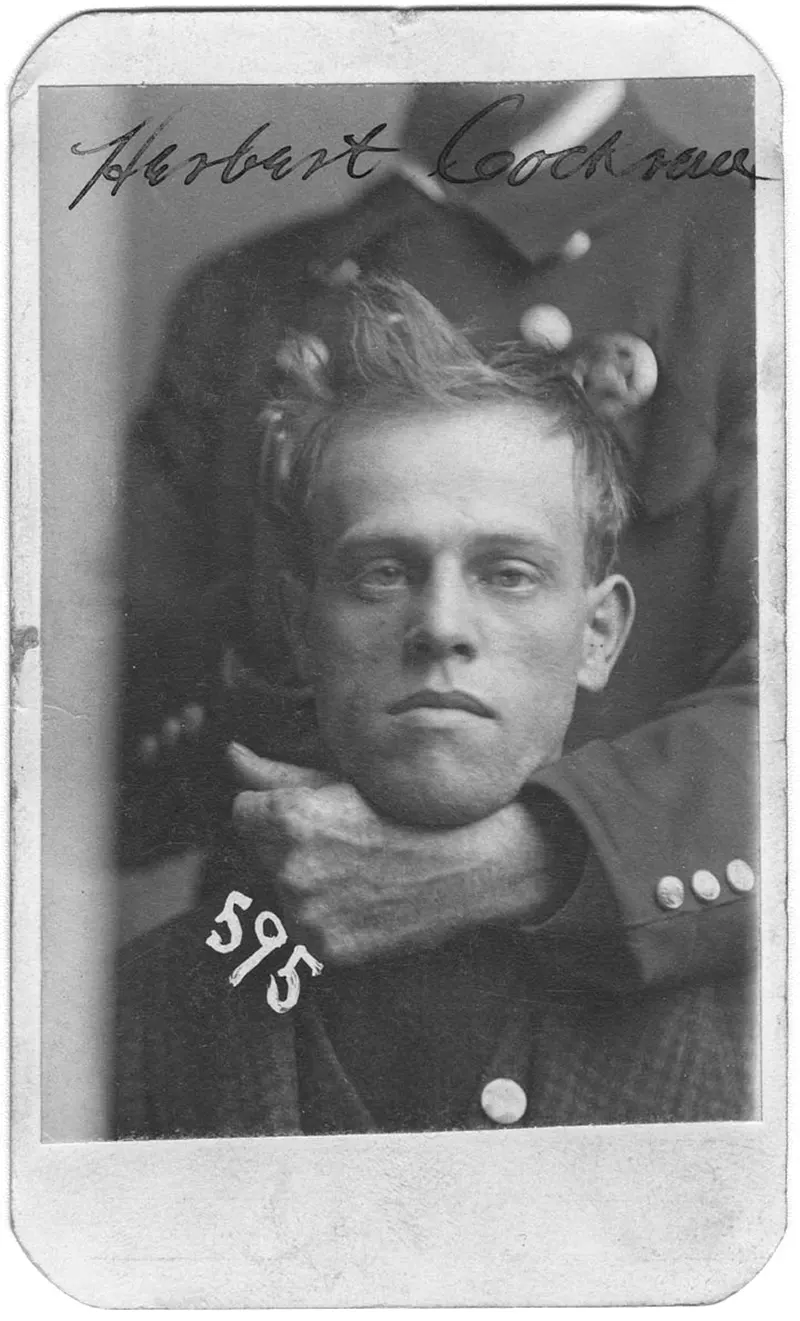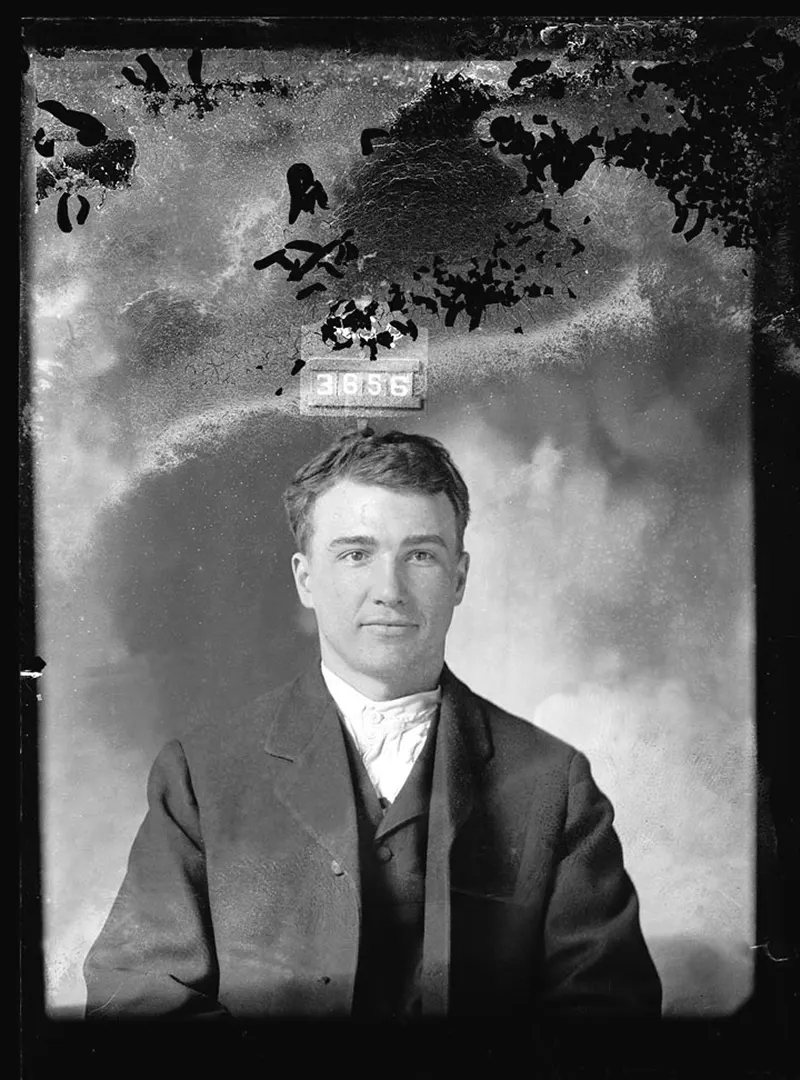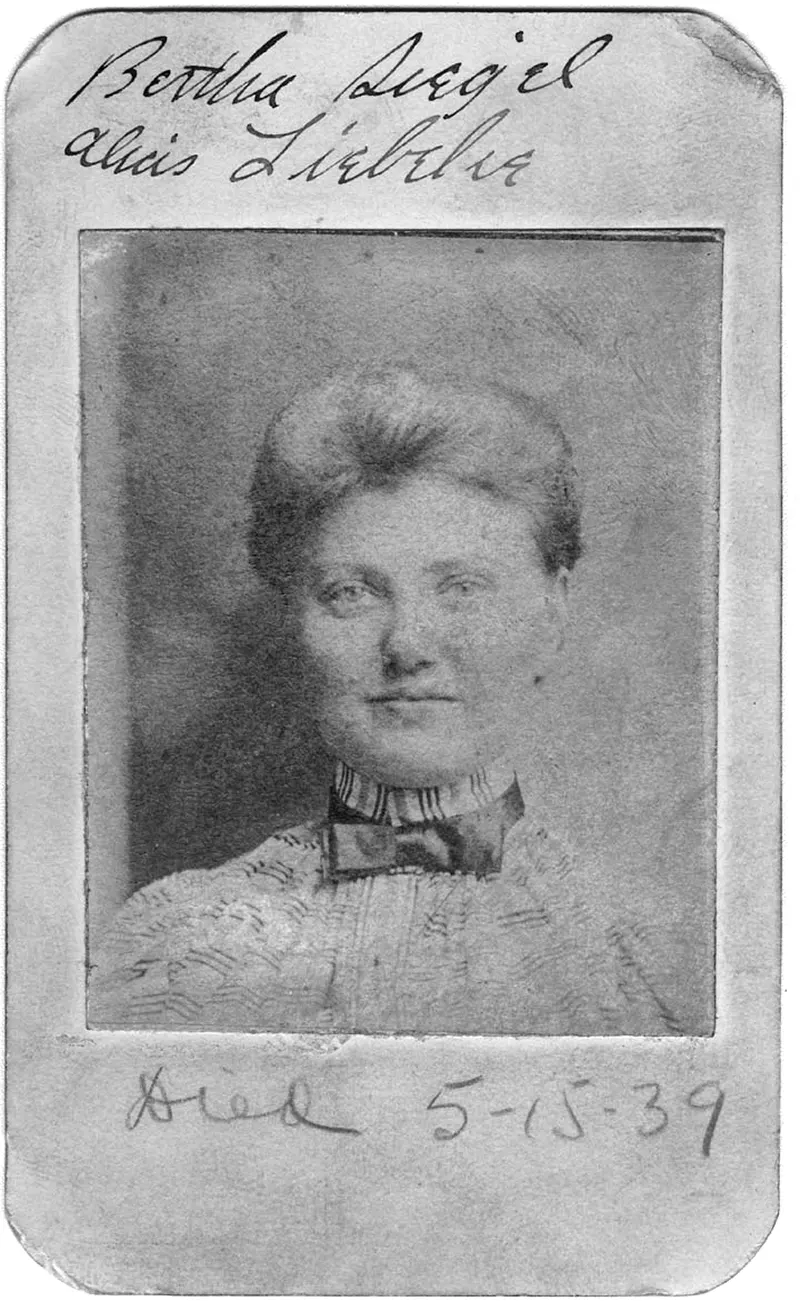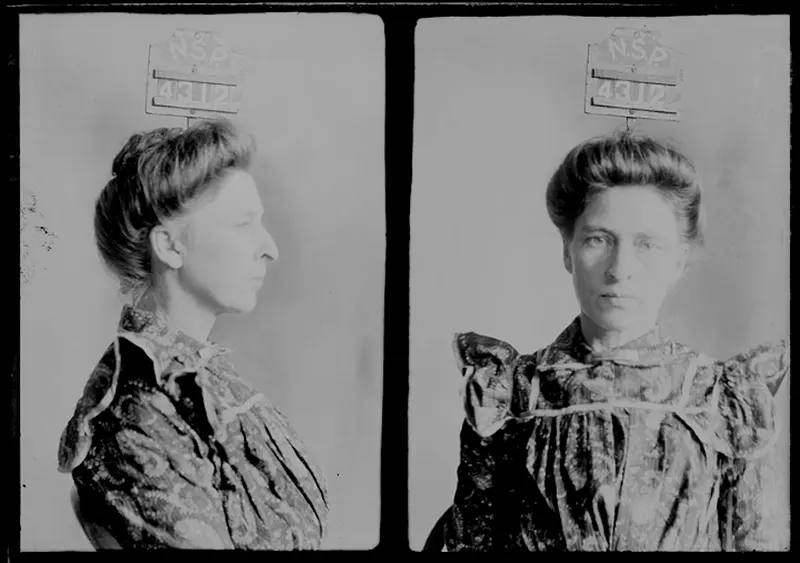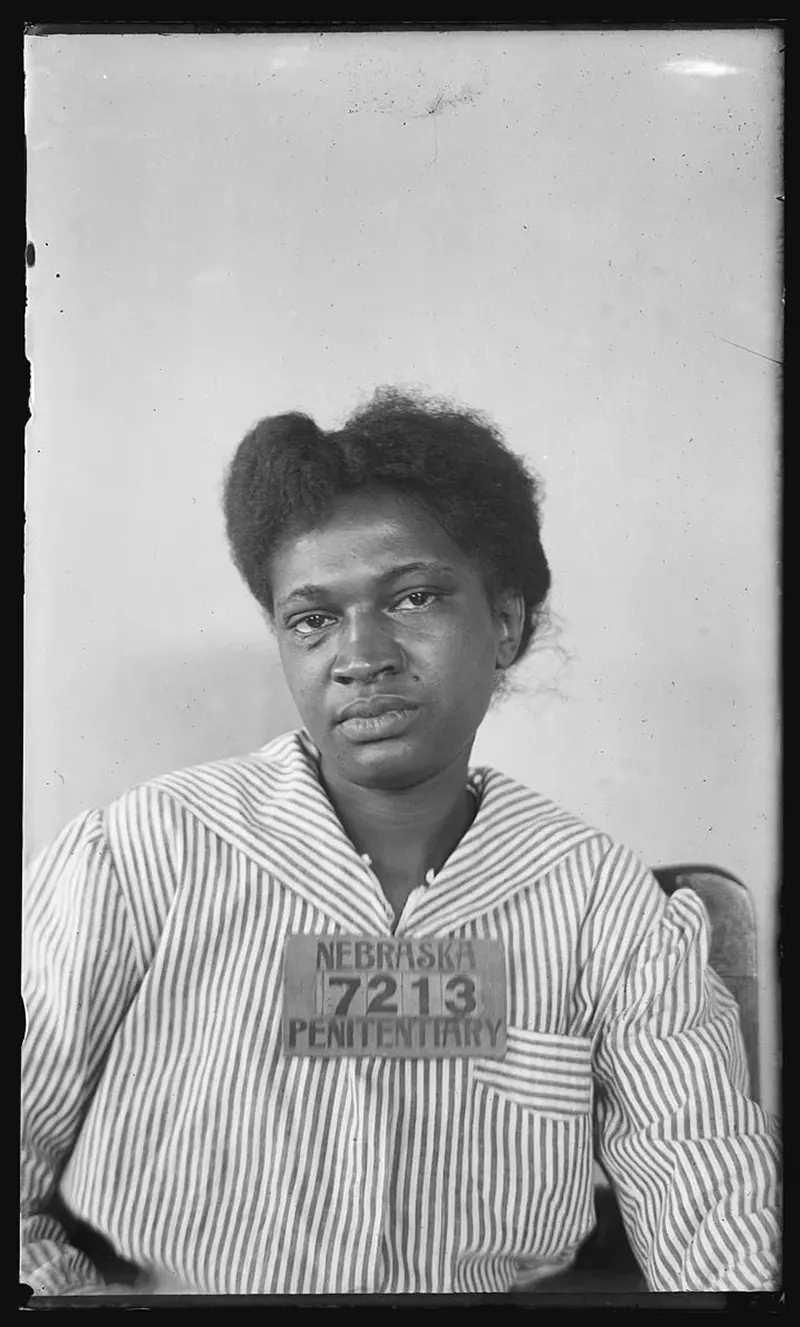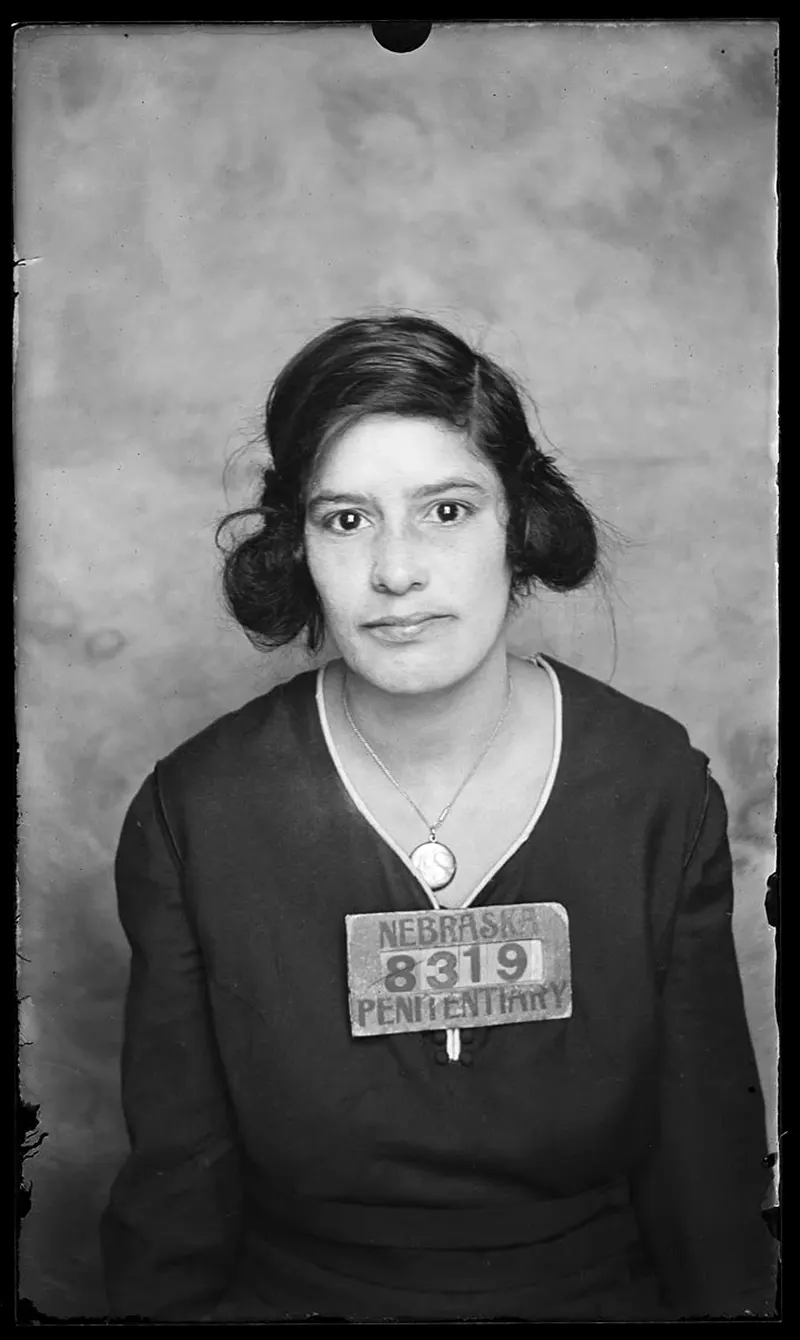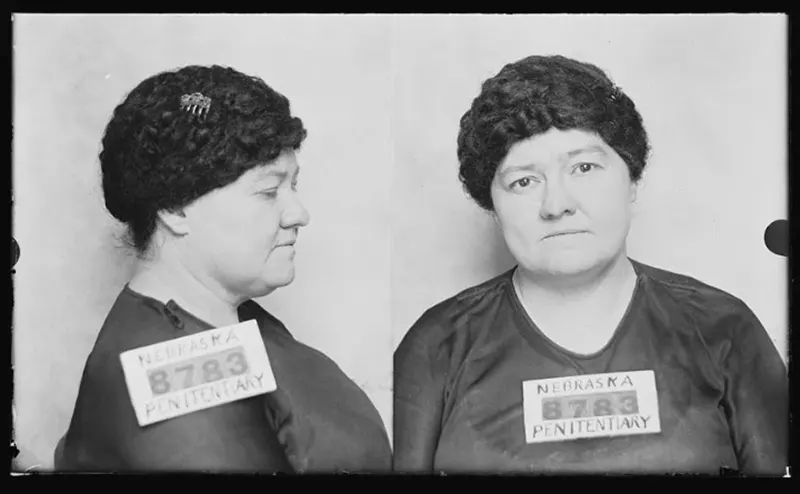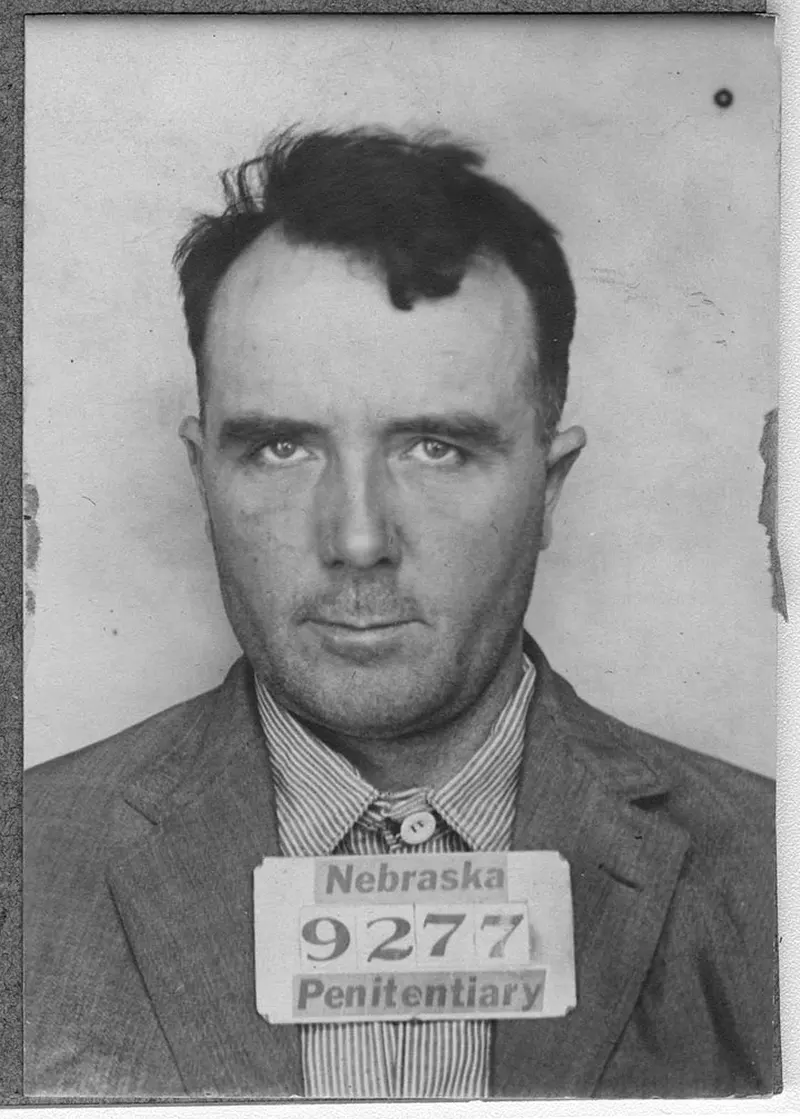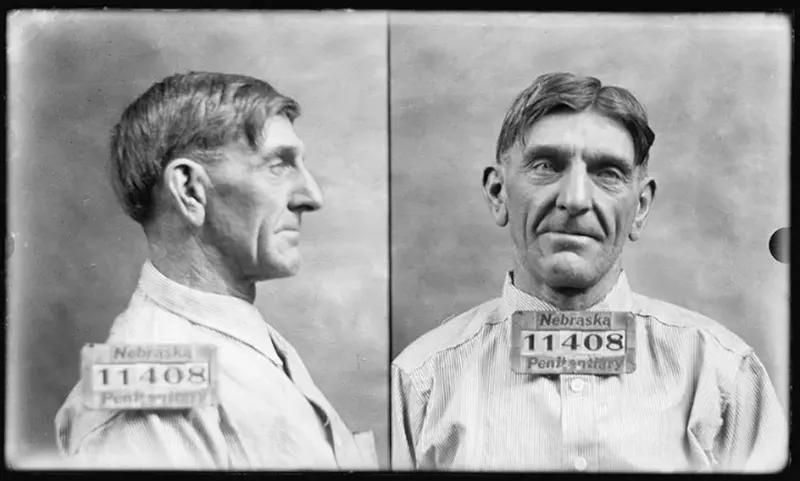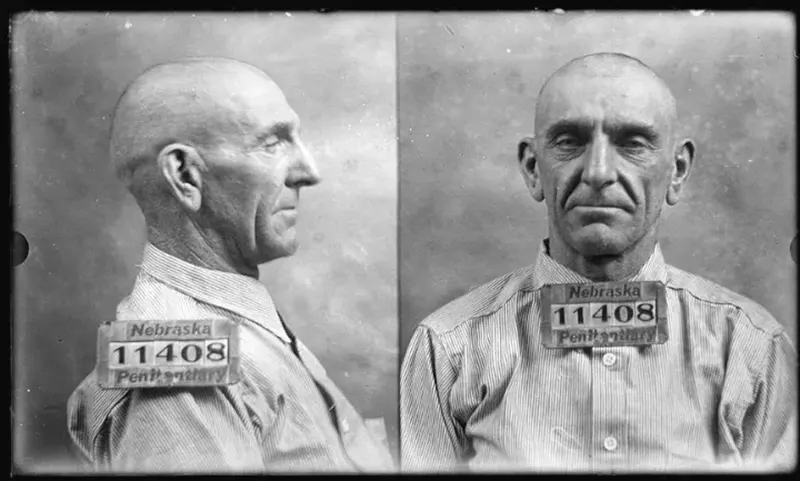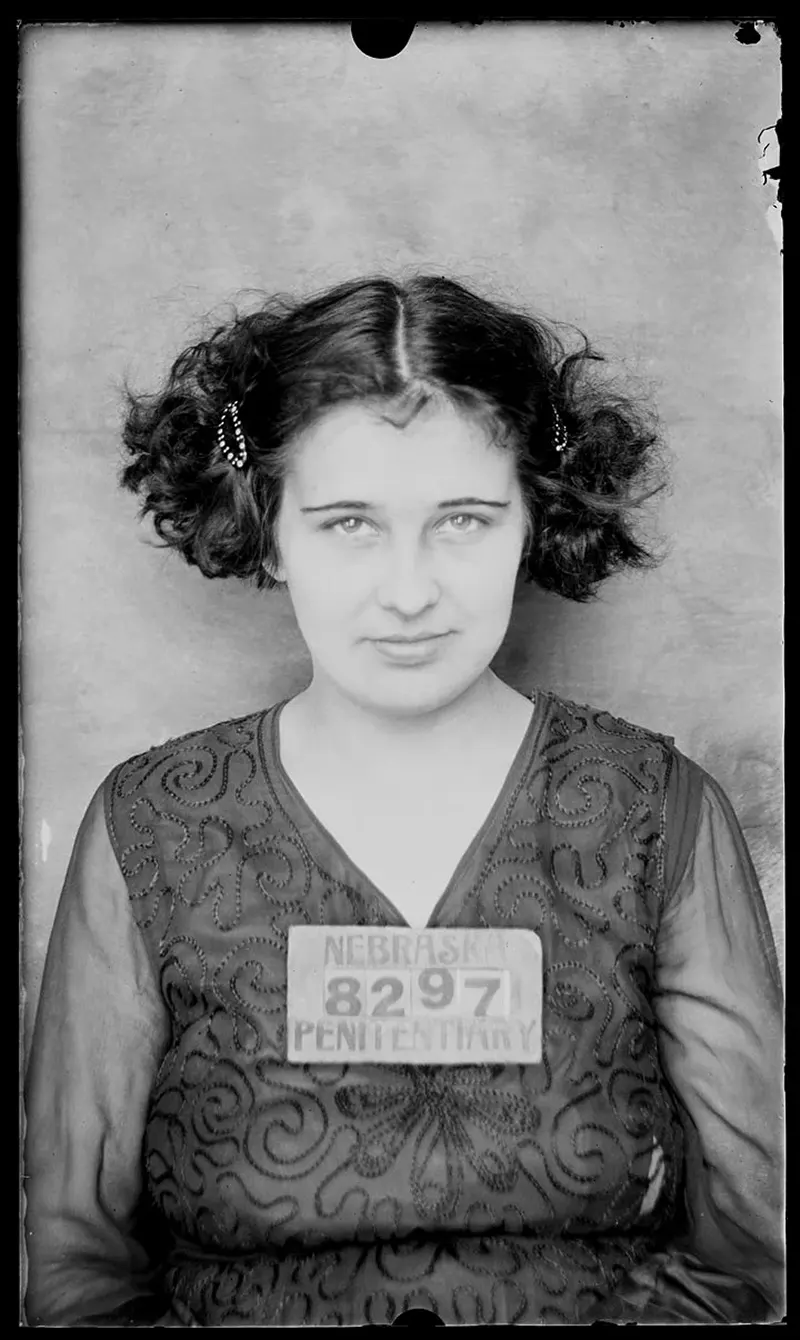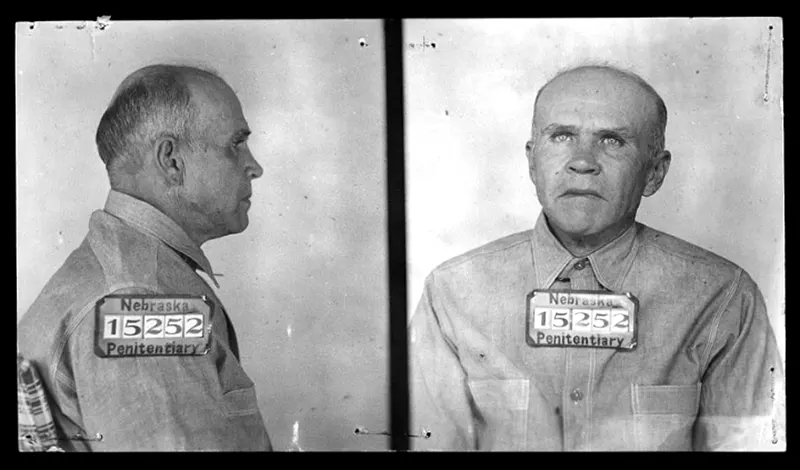Mug shot photography revolutionized crime investigations and enabled the police to keep visual records of the arrested criminals. Beginning in the mid-1800s, police photographed the faces of known criminals. Called “mug shots” (after the British slang word “mug” meaning “face”) these images replaced drawings and descriptions on wanted posters. Scientists even studied mug shots to see if physical traits could predict criminal behavior. If convicted, men had another set of images taken after their hair and beards were shaved off to limit the spread of lice. Women’s hair was not shaved. The Nebraska State Penitentiary used photography beginning in 1867 to record the likeness of the state’s most infamous residents. The Omaha police photographed suspects when arrested. Whether the people depicted were guilty or innocent, behind every photograph is a human story. These photographs of the Nebraska State Penitentiary and Omaha Police Court Collections offer a glimpse into the life of some random people more than 130 years ago. Many of the offenders in these mug shots were arrested for “grand larceny”. The crime of larceny is to deprive another person of their property, and the term is still used in the U.S. Larceny “from a person” refers to pickpockets. Another term that appears is “mayhem,” which refers to the permanent disfigurement or disabling of another person. The reactions these men and women had to being photographed varies. For instance, Herbert Cockran had to be restrained in a headlock; Minnie Bradley refused to look at the camera. George Ray, who served 10 years for manslaughter, managed a smile. James Whitewater killed two men. While in prison from 1872-1889, he embraced Christianity. In 1889, the Nebraska legislature passed an act allowing the governor to pardon two inmates who had “been in jail more than 10 years or whose conduct while incarcerated merited such mercy.” Albert Johnson arrived at the Nebraska State Prison sporting an impressive handlebar mustache. Johnson was sentenced to one year and six months for grand larceny. Because of prison policy to reduce lice, authorities shaved Johnson’s head and facial hair. Detailed descriptions and mug shots were important to police and prison authorities. Criminals easily changed names and created numerous identities. Typically, three mug shots were taken of each prisoner. Smiling faces in Victorian-era photographs are rare; George H. Ray grinning in a prison mug shot is truly unusual. Ray served 10 years for manslaughter in the late 1890s. People rarely smiled in 19th-century photographs. Long exposure times are often blamed for the lack of happy faces. By the end of the 19th century, advances in photographic technology reduced exposures to seconds but having a photograph taken by a professional remained a serious and sometimes sober occasion. James Collins was arrested in Omaha on May 12, 1897, for burglary. In his mug shot, Collin’s head has been bandaged. According to the police record, Collins escaped and was rearrested. The 23-year-old Omaha tailor was sent to the Nebraska State Prison on March 19, 1898, to serve a five-year sentence. Goldie Williams defiantly crossed her arms for her Omaha Police Court mug shot. Arrested for vagrancy on Jan. 29, 1898, Williams, also known as Meg Murphy, stood only five feet tall and weighed 110 pounds, according to police records. She listed her home as Chicago and her occupation as prostitute. According to her arrest descriptions, her left index finger was broken and she had a cut below her right wrist. Williams sports an elaborate hat with satin ribbons and feathers. She also wears large hoop earrings. Three burglars blew up a safe in a bank vault in Sheridan, Missouri, on the night of Feb. 15, 1898. They got away with about $2,400. The bank’s insurance company hired the famed Pinkerton Detective Agency and sent Assistant Superintendent F.H. Tollotson to hunt down the burglars. Tollotson tracked one of the wanted men through Missouri to Council Bluffs and eventually to a room at the Sheridan Hotel in Omaha. With the aid of the Omaha police, Tollotson apprehended a gun-welding fugitive after a brief struggle. The alleged bank robber gave his name as Charles Martin, but had several letters addressed to Charles Davis. Martin was unknown to Omaha police, but some detectives speculated to newspaper reporters he could be the notorious safe blower and bank robber Sam Welsh. At the time of his arrest, Martin had a gold watch and $565 in cash believed to be his share of the spoils of the Missouri bank robbery. Martin was taken to the police court where he was measured, photographed and locked up while he awaited his transfer to Missouri. Omaha police arrested Jim Ling for operating an opium joint, on June 3, 1898. The back of his mug shot lists his occupation as thief. Ling was described as five feet, six inches tall and weighing 104 pounds with black hair and hazel eyes. An unidentified member of the Omaha police force holds Herbert Cockran in a headlock during his mug shot. Cockran was arrested on Nov. 24, 1899, for burglary. A tailor from Fairmont, Nebraska, Cockran had a slightly stooped build with a fair complexion and his eyebrows met at the root of his nose, according to the police description. A double murder rocked the tiny town of Odessa, Buffalo County on the night of Dec. 4, 1899. Lillian Dinsmore was found dead in the kitchen of the house in which she and her charismatic husband Frank L. Dinsmore boarded. Fred Laue, the boarding house owner was shot in his bedroom. The Dinsmores had been married only a year. According to Fred Laue’s wife, Mr. Dinsmore became obsessed with her and seduced her. Unhappy in his marriage, Dinsmore supposedly plotted to kill his young wife and murder Laue. After she was murdered, Lillian Dinsmore’s brothers accused Dinsmore of using hypnotic powers on their vulnerable sister. After hearing the accusation, Mrs. Laue also claimed to be a victim of Dinsmore’s hypnotic influence. The Dinsmore case became a newspaper sensation. He vehemently denied all the charges even after the guilty verdict was read, and he was sentenced to death by hanging. Dinsmore’s lawyers appealed the sentence and Governor Dietrich stepped in to commute his sentence to life in prison. Dinsmore posed for his mug shot at the Nebraska State Prison wearing a simple white cotton shirt, sack jacket and striped prison-issue pants. Mrs. Adams was arrested in Omaha for blackmail. She listed her residence as Palisade, Nebraska, and her occupation as prostitute. The police record describes her as five feet, one inch tall with a medium build and a sallow complexion. Bert Martin was sentenced for stealing a horse in Keya Paha County. At the prison, Bert worked in the broom factory. One day, Bert’s cellmate of 11 months told the prison authorities a secret: Bert was really a woman named Lena Martin. In sparsely settled Keya Paha County, Lena’s masculine appearance allowed her to find work as a cowboy. Prison records show Martin was transferred to the women’s division on Sept. 22, 1901. When Martin was sentenced, a woman, believed to be Martin’s wife stood beside him. Martin was sentenced to two years. The Governor of Nebraska Ezra P. Savage said of her: “a sexual monstrosity, unfit for association with men or women even in a penal institution, and on the solemn promise of its aged mother to care for it and guard it, and that prison morals imperatively demanded its removal, the sentence was commuted to one year, six months, Feb. 3, 1902.” Nora Courier was better known as “Red Nora.” On March 31, 1901, Omaha police arrested Nora for stealing a horse. According to police court records, she was 22 years old and stood five feet, three inches tall. She had slate blue eyes and a scar on the center of her forehead. Robinson attempted to pay for a glass of beer in a lower Douglas Street saloon in Omaha with a Mexican dollar, on Nov. 21, 1901. The beer cost only a nickel and Robinson received 95 cents of American money in change. At the time, the foreign dollar looked very similar to the American currency but was only worth about 45 cents. This clever money scam left Robinson 50 cents and a glass of lager ahead of the game until he was arrested. George Leonard, an Omaha bookkeeper, was arrested for burglary on Dec. 23, 1901. His large silk bowtie sits slightly askew against his stiffly collared shirt. Minnie Bradley refuses to look at the camera in her Omaha Police Court mug shot. Minnie, 27, and 5’2″, was arrested in Omaha for larceny from a person. She listed her residence on North 11th Street in Omaha and her occupation as prostitute. The description also noted that Minnie wore a wig. Bertha Liebbeke earned the reputation of being one of the Midwest’s most notorious pickpockets. She would search out a well-dressed man, ideally with a diamond-studded lapel pin. Bertha would then “accidentally” stumble into the helpless victim, pretending to faint in his arms. While he attempted to help her, Bertha would relieve the gentleman of his valuables or wallet. This trick earned her the nickname “Fainting Bertha.” Authorities from Illinois, Kansas, Iowa, Missouri and Nebraska knew Bertha and her tricks. Her aliases included Bertha Liebke, Jennie Jennings, Bertha Nixon, J. Armstrong, Carrie Jones, Bessie Milles, Menni Swilson and Bertha Siegel, the name on her Omaha Police Court mug shot. On Nov. 1, 1903, Eli Feasel disappeared from his farm southwest of Bostwick, Nebraska, about 15 miles east of Red Cloud. His housekeeper, Nannie Hutchinson (pictured below), said he went to visit his son in Kansas City. Feasel’s brother, Thomas, grew suspicious when inquiries found no trace of Eli. The investigation led to the arrest of the housekeeper and her 21-year-old son Charles. With little evidence that a crime had been committed, they were released after their hearing. The following spring, a Mr. Stanley began farming Eli Feasel’s place. While working in a field, he found what appeared to be a newly opened grave. Upon close examination, authorities discovered a human hand, some hair from a man’s head, part of a coat with an empty whisky bottle in the pocket, and other pieces of clothing. Authorities believed Charles Hutchinson had seen Mr. Stanley plowing the field where the grave was later discovered. Charles began to act suspiciously. On May 6, he rented a buggy. He said was going to assist in taking the rig to Starke Ranch at Amboy, about five miles east. The next morning, Charles returned the rig to the livery stable in Red Cloud and paid the usual fee to Amboy. The team of horses used by Charles appeared to have had a longer drive than a trip to Amboy. Stable workers also noticed a terrible stench emanating from the rented buggy and cushions. They paid little attention to it until Mr. Stanley discovered the open grave in Eli Feasel’s place. With the new evidence, authorities quickly rearrested Charles and his mother Nannie. Authorities believed that on the night Charles rented the buggy, he and his mother returned to the site where they had hidden Feasel’s body in order to move the remains. The Hutchinson’s had left telltale clues behind them: footprints of a man and woman corresponding to their shoe sizes. At trial, the Hutchinsons were found guilty of second-degree murder. On the evening of May 13, 1906, a violent confrontation occurred between the African American members of Troop B, Tenth United States Cavalry Regiment, and the townspeople of Crawford, Nebraska. A year before, Crawford Marshal Arthur Moss and Sergeant John Reid of Troop B had come close to blows after a July 4 horse race. The animosity between the two men continued. On the evening of May 13, Moss was sent to break up a soldier’s beer party near the city park on the west edge of town. Moss ordered the party to quiet down or disperse. An altercation broke out between Moss, Reid and Pvt. Jordan Taylor, also from Troop B. During the brief scuffle, Reid shot Moss with a .38-caliber revolver. Reid and Taylor fled into town and took refuge at the home of Edna Ewing, an elder black resident. While making their escape, the soldiers were followed and fired upon by several civilians. Art Moss died shortly after being shot. As a crowd gathered at the Ewing house, Taylor suddenly bolted and ran towards Fort Robinson. Before getting very far, he was fatally wounded. Reid was captured and taken under guard to the city jail. Rumors spread through Crawford that solders from Fort Robinson had threatened to storm the jail and free Reid. City officials feared a civilian mob might seize and lynch the prisoner. So, they decided to move Reid to the Chadron jail for safety. Before he could be transported, word came from the fort that several men and rifles from Troop B were missing. Colonel Augur quickly sent Troops I and K into town to prevent further violence. Soldier guards surrounded the jail. Tensions remained high into the next day. The seven men who were reported absent from the B Troop barracks were placed in the post guardhouse and 14 rifles were found concealed near the town limits. Reid was moved to the Chadron jail. He was eventually tried and convicted of manslaughter for the death of Arthur Moss and sentenced to seven years at the Nebraska State Prison. Alberto Interciago was sentenced to one to 20 years at the Nebraska State Prison for “assault to wound” in February 1914. In the first photograph, Interciago sports a thick mustache popularized by rebel leaders Emiliano Zapata and Pancho Villa during the Mexican Revolution, 1910-1920. The second set of mug shots shows Interciago after his hair and mustache were shaved. Jennie Lester strikes a defiant pose in her mug shot. Lester was arrested in Phelps county for enticing to illicit intercourse in March 1914. She was sentenced to one to three years in the Nebraska State Prison. Thomas Whitney, known to his clients as The Professor, advertised extensively in Omaha newspapers as a clairvoyant, palmist, and astrologer. Whitney claimed he had no equal in giving advice on love, law, deeds, wills, mining, divorce, changes, investments, patents and all other business of a financial nature. Readings cost only $1 for gentlemen and $.50 for ladies. One of his customers proved to be unsatisfied with the readings, and The Professor was arrested for obtaining money under false pretenses in December 1915. According to the description on his mug shot, Whitney had tattoos on both of his arms. In November 1916, Shock was sentenced to two years at the Nebraska State Prison for grand larceny. According to his prison records, he enlisted in the United States Army shortly after his release in February 1918 to serve in World War I. Mattie Brown was sent to the Nebraska State Prison for one year, for larceny from a person in Douglas County. “Larceny of a person” was often the legal term for the crime of pickpocketing. Nebraska’s prohibition law went into effect on May 1, 1917, outlawing the manufacturing and sale of liquor. Soon after Nebraska jails began filling with liquor law violators. William H. Lee was sentenced to six months to two years in the Nebraska State Prison for bootlegging in Hitchcock County, in December 1919. “Bootlegging” is the illegal business of transporting alcoholic beverages. According to his official file, prison authorities granted Lee a furlough to visit his terminally ill wife. He returned to prison and was released on July 4, 1921. Lola Lopez wears a large gold locket in her Nebraska State Prison mug shot. In a moment of “blind greed,” her companion Cicerio Estrada clubbed, strangled, and robbed Stephen Pann in the Null Rooming House in Sidney, Nebraska, on Jan. 9, 1922. Estrada and Lopez fled hours before the murder was discovered. They were captured in Greeley, Colorado, and were returned to Sidney to stand trial. Through an interpreter, the Mexican-born Lopez pleaded not guilty but did admit to having knowledge of the murder. She served two years, two months, and 22 days. Mary Shannon was sentenced to two years in the Nebraska State Prison for mayhem in May 1925. Her records do not explain what she did to be charged with mayhem. A legal definition of mayhem is “the criminal act of disabling, disfiguring, or cutting off or making useless one of the members (leg, arm, hand, foot, eye) of another either intentionally or in a fight, called maiming.” The serious nature of the injury makes mayhem a felony, which is called “aggravated assault” in most states. In February 1926, Frank Carter, dubbed the “Omaha Sniper,” terrorized the city of Omaha. He shot people at random, sometimes using a silencer on his pistol. Omaha newspapers recommended a blackout, as people were shot as they stood at their lighted windows. Carter brought Omaha to a standstill, with empty streets, for over a week. He was captured on Feb. 26 and tried for the murder of two people, but he claimed to have killed 43. His lawyers tried to plead insanity, but he was found guilty and executed by electrocution in June 1927. Carter’s last words were reported to have been “let the juice flow.” Jake Vohland (below he is pictured shaved) attempted to steal chickens from Mr. and Mrs. Stubblefield. The Stubblefields, however, had devised an ingenious homemade burglar alarm to protect their large chicken farm in Gibbon. They placed a mousetrap near the door of the chicken barn that rang bells in both their living room and bedroom. Vohland unknowingly set off the burglar alarm on a dark night in March 1931. The alleged thief ran out of the chicken house refusing to stop when Mr. Stubblefield cried halt. In his attempt to flee the scene, the alleged thief dropped part of his booty and escaped with only 10 chickens at a value of over $5. In his haste, the burglar did not stop for his car and made his getaway on foot. Mr. Stubblefield parked near the abandoned car and notified the sheriff. The sheriff quickly determined the car belonged to Vohland and proceeded to his home. Vohland was placed under arrest despite his claims that the car was stolen by someone else for the purpose of the chicken house raid. The jury did not believe Vohland’s story. He was found guilty of theft and sentenced to one year in the Nebraska State Prison. James Pappas‘ mug shot card reads: “This man operated a General Store in Deweese, Nebraska, upon which he carried heavy insurance. He had a young man working for him and incited him to set fire to the store with the intention of collecting the insurance.” Alv Lytle (below, with shaved head) was sentenced to 12-15 years in the Nebraska State Prison for bank robbery in Kearney County, Nebraska. Another man confessed to the crime and the state paid Lytle $2,500 for false imprisonment. He served two yrs and seven days for a crime he did not commit. Ruby Fox and Myrtle Hetrick (below) met while incarcerated at the State Reformatory for Women in York, Nebraska. Ruby was serving time for breaking and entering, and Myrtle for vagrancy. Unhappy with their treatment, Ruby and Myrtle engineered an escape. With the aid of an unnamed man, the two women fled Nebraska in an automobile. Authorities in Casper, Wyoming captured the fugitives. Upon their return to Nebraska, Ruby and Myrtle requested to go to the Nebraska State Prison rather than return to the woman’s reformatory in York. They received their wish and were sentenced to one year at the Nebraska State Prison for their escape. Amos Holloman was a repeat offender. Each time he entered the prison system he was given a new number. These mugshots (below) show how he aged. (Photo credit: Nebraska State Historical Society / Mashable). Notify me of new posts by email.
Δ Subscribe

